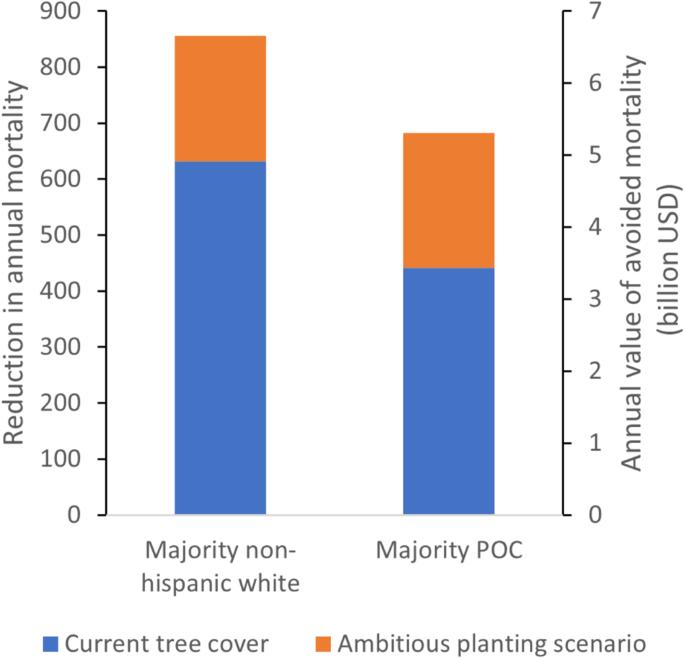Current inequality and future potential of US urban tree cover for reducing heat-related health impacts
IF 8.8
Q1 ENVIRONMENTAL STUDIES
引用次数: 0
Abstract
Excessive heat is a major and growing risk for urban residents. Here, we estimate the inequality in summertime heat-related mortality, morbidity, and electricity consumption across 5723 US municipalities and other places, housing 180 million people during the 2020 census. On average, trees in majority non-Hispanic white neighborhoods cool the air by 0.19 ± 0.05 °C more than in POC neighborhoods, leading annually to trees in white neighborhoods helping prevent 190 ± 139 more deaths, 30,131 ± 10,406 more doctors’ visits, and 1.4 ± 0.5 terawatt-hours (TWhr) more electricity consumption than in POC neighborhoods. We estimate that an ambitious reforestation program would require 1.2 billion trees and reduce population-weighted average summer temperatures by an additional 0.38 ± 0.01 °C. This temperature reduction would reduce annual heat-related mortality by an additional 464 ± 89 people, annual heat-related morbidity by 80,785 ± 6110 cases, and annual electricity consumption by 4.3 ± 0.2 TWhr, while increasing annual carbon sequestration in trees by 23.7 ± 1.2 MtCO2e yr−1 and decreasing annual electricity-related GHG emissions by 2.1 ± 0.2 MtCO2e yr−1. The total economic value of these benefits, including the value of carbon sequestration and avoided emissions, would be USD 9.6 ± 0.5 billion, although in many neighborhoods the cost of planting and maintaining trees to achieve this increased tree cover would exceed these benefits. The exception is areas that currently have less tree cover, often the majority POC, which tend to have a relatively high return on investment from tree planting.

美国城市树木覆盖在减少与热有关的健康影响方面的当前不平等状况和未来潜力
过热是城市居民面临的一个主要且日益严重的风险。在此,我们估算了在 2020 年人口普查期间,美国 5723 个城市和其他地方的 1.8 亿居民在夏季与高温相关的死亡率、发病率和耗电量方面的不平等情况。平均而言,非西班牙裔白人聚居区的树木比其他白人聚居区多冷却空气 0.19 ± 0.05 °C,因此白人聚居区的树木每年比其他白人聚居区多帮助预防 190 ± 139 例死亡、30131 ± 10406 次就诊和 1.4 ± 0.5 太瓦时(TWhr)的电力消耗。我们估计,一项雄心勃勃的植树造林计划将需要 12 亿棵树,并将人口加权夏季平均气温额外降低 0.38 ± 0.01 °C。气温降低后,每年与高温相关的死亡人数将增加 464 ± 89 人,每年与高温相关的发病人数将减少 80,785 ± 6110 例,每年的耗电量将减少 4.3 ± 0.2 太瓦时,同时树木每年的固碳量将增加 23.7 ± 1.2 兆吨二氧化碳当量/年,每年与电力相关的温室气体排放量将减少 2.1 ± 0.2 兆吨二氧化碳当量/年。这些效益的总经济价值(包括碳固存价值和避免的排放)将达到 96 ± 5 亿美元,但在许多地区,为增加树木覆盖率而种植和维护树木的成本将超过这些效益。但目前树木覆盖率较低的地区是个例外,这些地区通常以 POC 居多,植树的投资回报率相对较高。
本文章由计算机程序翻译,如有差异,请以英文原文为准。
求助全文
约1分钟内获得全文
求助全文

 求助内容:
求助内容: 应助结果提醒方式:
应助结果提醒方式:


